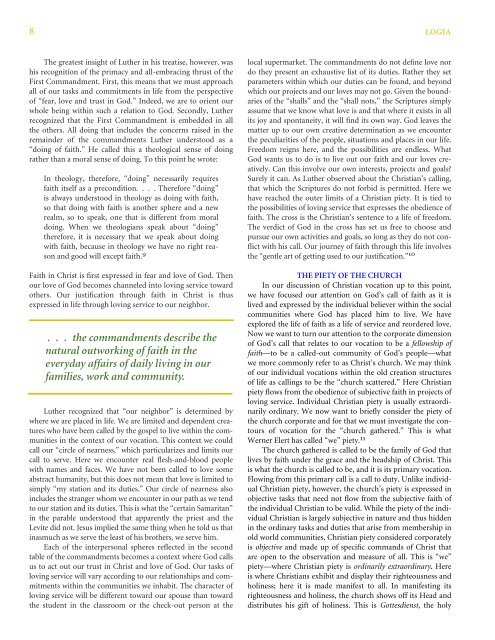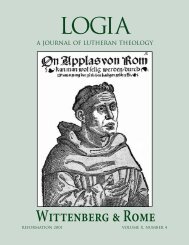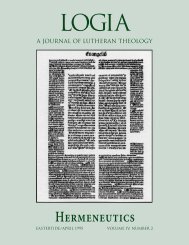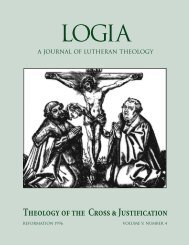03-1 Pastoral Care.pdf
03-1 Pastoral Care.pdf
03-1 Pastoral Care.pdf
- No tags were found...
Create successful ePaper yourself
Turn your PDF publications into a flip-book with our unique Google optimized e-Paper software.
8 LOGIAThe greatest insight of Luther in his treatise, however, washis recognition of the primacy and all-embracing thrust of theFirst Commandment. First, this means that we must approachall of our tasks and commitments in life from the perspectiveof “fear, love and trust in God.” Indeed, we are to orient ourwhole being within such a relation to God. Secondly, Lutherrecognized that the First Commandment is embedded in allthe others. All doing that includes the concerns raised in theremainder of the commandments Luther understood as a“doing of faith.” He called this a theological sense of doingrather than a moral sense of doing. To this point he wrote:In theology, therefore, “doing” necessarily requiresfaith itself as a precondition. . . . Therefore “doing”is always understood in theology as doing with faith,so that doing with faith is another sphere and a newrealm, so to speak, one that is different from moraldoing. When we theologians speak about “doing”therefore, it is necessary that we speak about doingwith faith, because in theology we have no right reasonand good will except faith. 9Faith in Christ is first expressed in fear and love of God. Thenour love of God becomes channeled into loving service towardothers. Our justification through faith in Christ is thusexpressed in life through loving service to our neighbor.. . . the commandments describe thenatural outworking of faith in theeveryday affairs of daily living in ourfamilies, work and community.Luther recognized that “our neighbor” is determined bywhere we are placed in life. We are limited and dependent creatureswho have been called by the gospel to live within the communitiesin the context of our vocation. This context we couldcall our “circle of nearness,” which particularizes and limits ourcall to serve. Here we encounter real flesh-and-blood peoplewith names and faces. We have not been called to love someabstract humanity, but this does not mean that love is limited tosimply “my station and its duties.” Our circle of nearness alsoincludes the stranger whom we encounter in our path as we tendto our station and its duties. This is what the “certain Samaritan”in the parable understood that apparently the priest and theLevite did not. Jesus implied the same thing when he told us thatinasmuch as we serve the least of his brothers, we serve him.Each of the interpersonal spheres reflected in the secondtable of the commandments becomes a context where God callsus to act out our trust in Christ and love of God. Our tasks ofloving service will vary according to our relationships and commitmentswithin the communities we inhabit. The character ofloving service will be different toward our spouse than towardthe student in the classroom or the check-out person at thelocal supermarket. The commandments do not define love nordo they present an exhaustive list of its duties. Rather they setparameters within which our duties can be found, and beyondwhich our projects and our loves may not go. Given the boundariesof the “shalls” and the “shall nots,” the Scriptures simplyassume that we know what love is and that where it exists in allits joy and spontaneity, it will find its own way. God leaves thematter up to our own creative determination as we encounterthe peculiarities of the people, situations and places in our life.Freedom reigns here, and the possibilities are endless. WhatGod wants us to do is to live out our faith and our loves creatively.Can this involve our own interests, projects and goals?Surely it can. As Luther observed about the Christian’s calling,that which the Scriptures do not forbid is permitted. Here wehave reached the outer limits of a Christian piety. It is tied tothe possibilities of loving service that expresses the obedience offaith. The cross is the Christian’s sentence to a life of freedom.The verdict of God in the cross has set us free to choose andpursue our own activities and goals, so long as they do not conflictwith his call. Our journey of faith through this life involvesthe “gentle art of getting used to our justification.” 10THE PIETY OF THE CHURCHIn our discussion of Christian vocation up to this point,we have focused our attention on God’s call of faith as it islived and expressed by the individual believer within the socialcommunities where God has placed him to live. We haveexplored the life of faith as a life of service and reordered love.Now we want to turn our attention to the corporate dimensionof God’s call that relates to our vocation to be a fellowship offaith—to be a called-out community of God’s people—whatwe more commonly refer to as Christ’s church. We may thinkof our individual vocations within the old creation structuresof life as callings to be the “church scattered.” Here Christianpiety flows from the obedience of subjective faith in projects ofloving service. Individual Christian piety is usually extraordinarilyordinary. We now want to briefly consider the piety ofthe church corporate and for that we must investigate the contoursof vocation for the “church gathered.” This is whatWerner Elert has called “we” piety. 11The church gathered is called to be the family of God thatlives by faith under the grace and the headship of Christ. Thisis what the church is called to be, and it is its primary vocation.Flowing from this primary call is a call to duty. Unlike individualChristian piety, however, the church’s piety is expressed inobjective tasks that need not flow from the subjective faith ofthe individual Christian to be valid. While the piety of the individualChristian is largely subjective in nature and thus hiddenin the ordinary tasks and duties that arise from membership inold world communities, Christian piety considered corporatelyis objective and made up of specific commands of Christ thatare open to the observation and measure of all. This is “we”piety—where Christian piety is ordinarily extraordinary. Hereis where Christians exhibit and display their righteousness andholiness; here it is made manifest to all. In manifesting itsrighteousness and holiness, the church shows off its Head anddistributes his gift of holiness. This is Gottesdienst, the holy
















